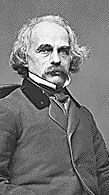 |
||
  |
||
|
|
Hawthorne: Author and NarratorIntroductionIn fiction, the first-person narrator is usually distinct from the author. Understanding the differences, subtle or pronounced, between an author and the narrator he or she creates is essential to understanding a work of fiction. Learning ObjectivesTo recognize the difference between a narrator and an author; to explore the impact of an author's personal history on his or her creative life, particularly in the context of American society.Suggested Activities1 Help students understand how the point of view of the narrator and the point of view of the author are not the same. How does the author represent the narrator? Do they necessarily share common opinions, beliefs, or characteristics? Have students write a short description of the narrator of The Scarlet Letter, drawing evidence from the introductory chapter and elsewhere in the book. Or you might have students write a short description of school life in the style of the novel's narrator. Another way to understand narrative perspective is to think about how The Scarlet Letter would be different if one of the other characters, such as Hester, Dimmsdale, or Pearl, were the narrator. Have students write a passage from the story from the perspective of one of these other characters. 2 Help students to see Hawthorne in the context of his times, as a contemporary of Henry David Thoreau, Ralph Waldo Emerson, Louisa May Alcott, Frederick Douglass, Elizabeth Cady Stanton, Herman Melville, Margaret Fuller, Walt Whitman, and Abraham Lincoln. To what extent was he engaged by the transforming political and technological forces at work in his society, and to what extent was he (like the narrator of The Scarlet Letter) estranged from his times by an overriding attachment to the American past? Extending the LessonTo complete this study of Hawthorne's literary and literal lives, have small groups of students each read a Hawthorne short story from different periods in his later life. (Students can find appropriate stories on the Nathaniel Hawthorne website or in the library.) Ask each group to report on the narrative point of view represented in their story, citing passages from the text to support their views. Compare narrators from The Scarlet Letter and a short story. What is the point of view of each narrator? Why did Hawthorne choose these narrators?Selected EDSITEment WebsitesAcademy of American PoetsThe Life and Works of Herman Melville Women and Social Movements in United States, 1820-1940 Standards Alignment View your state’s standards |
||||||||||||||||||||||||||||||||||||||||||||||||||||
  |
||
| EDSITEment contains a variety of links to other websites and references to resources available through government, nonprofit, and commercial entities. These links and references are provided solely for informational purposes and the convenience of the user. Their inclusion does not constitute an endorsement. For more information, please click the Disclaimer icon. | ||
| Disclaimer | Conditions of Use | Privacy Policy Search
| Site
Map | Contact
Us | ||
